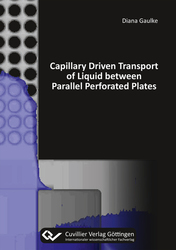| Areas | |
|---|---|
| Serie de libros (96) |
1378
|
| Nachhaltigkeit |
3
|
| Gesundheitswesen |
1
|
| Letra |
2365
|
| Ciencias Naturales |
5406
|
| Ciencias Ingeniería |
1793
|
| Ingeniería | 292 |
| Ingeniería mecánica y de proceso | 862 |
| Ingeniería eléctrica | 686 |
| Mineria y metalurgía | 30 |
| Arquitectura e ingeniería civil | 75 |
| General |
98
|
|
Leitlinien Unfallchirurgie
5. Auflage bestellen |
|
Erweiterte Suche
Capillary Driven Transport of Liquid between Parallel Perforated Plates (Tienda española)
Diana Gaulke (Autor)Previo
Lectura de prueba, Datei (840 KB)
Indice, Datei (540 KB)
In the propellant tanks of a spacecraft it is of high importance to position the liquid propellant stably at the outlet or use mechanisms to transport it reliably to the desired position during all flight phases. For this purpose, special devices are placed at the outlet which use the capillary forces of a liquid as the driving mechanism controlling the liquid distribution. These capillary forces result from the phenomenon, that a liquid between two solid bodies builds a curved free surface which drives the liquid to movement. Due to mass reduction or functional purposes these solid structures may be perforated. The perforation of the solid structures changes the capillary transport capability of the implemented devices. In literature, several analyses can be found about the singular aspects of capillary transport between solids, in channels of changing cross-sectional area and multi channel systems. However, the combined process of capillary transport between perforated plates has not been analysed yet.
In this present study the main geometrical aspects of perforated plates are investigated by means of a parameter variation. The impact of this variation on the capillary transport capability is documented. Three methods are used to analyse behaviour of the liquid propellant: As a first step, a one-dimensional model is built using and combining existing models for the representation of the different fluid mechanical aspects. Secondly, an experiment was set up and tests were performed in order to obtain reliable data which were used to thirdly, validate a numerical model. This numerical model was used to consolidate the experimental study. The results of these three methods were compared using different parameter variations. Six geometrical measures were identified as independent geometrical parameters occuring in parallel perforated plates.
A variation of each of these parameters was conducted and its impact on the capillary transport capability analysed. For the one-dimensional model two additional factors have been introduced, which were calculated using the numerical and experimental data. These two factors could be determined as constant or independently calculable values.
| ISBN-13 (Impresion) | 9783736992368 |
| ISBN-13 (E-Book) | 9783736982369 |
| Formato | A5 |
| Idioma | Inglés |
| Numero de paginas | 214 |
| Laminacion de la cubierta | Brillante |
| Edicion | 1. |
| Lugar de publicacion | Göttingen |
| Fecha de publicacion | 26.04.2016 |
| Clasificacion simple | Tesis doctoral |
| Area |
Ingeniería
Mecánica de medida Ingeniería mecánica y de proceso Ingeniería aeroespacial |
| Palabras claves | Fluid dynamics, Microgravity, Capillarity, Contact angle, Wetting, CFD, Flow3D |








